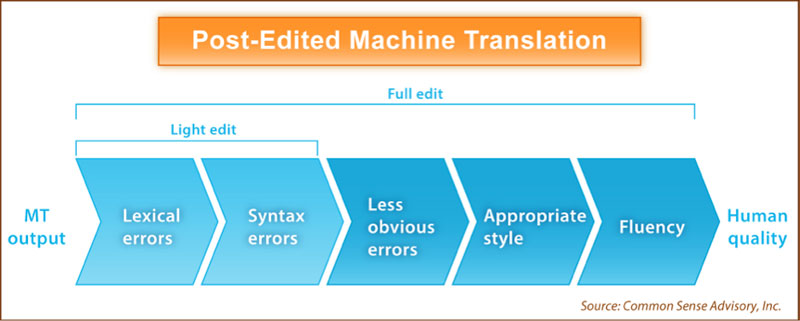Post-editing is the process by which humans review, edit, and improve the quality and usefulness of machine translation output. From light to full post-editing, the service – and price – varies largely according to the needs of the translation buyer. Here is an insight into the process and the types of services available in the marketplace.
Translation buyers can choose between two levels of post-edited machine translation (PEMT): light and full. These two types differ based on the human effort required to improve the usability of machine-translated text (Figure 1). So what do they involve?

Figure 1: The journey from raw machine translation to human quality
Light post-editing converts raw MT output into understandable and usable, but not linguistically or stylistically perfect, text. An editor corrects obvious errors such as mistranslations and terminology mistakes, along with phrases or tags that shouldn’t be translated. A reader can usually determine that the text was machine-translated and touched up by a human. Language Service Providers (LSPs) tell us that a translator doing light post-editing, also called “rapid post-editing,” can produce up to 20,000 words per day versus 2,700 without MT.
Full post-editing, on ...
Read more after login
tekom members can log in directly with their "My tekom" access data.
You are not yet a tekom member, but would like to read one or more articles in full? Then you have the opportunity to register on the internet portal of the technical journal 'tcworld' without obligation. Once you have registered, you can select any three specialist articles and view them in full for a period of two months. The selection will then be deleted and you can select three new articles for the next two months.
As a tekom member you benefit from the following advantages::
- Online access to all articles of the trade magazine 'tcworld magazine'
- Exclusive specialist articles from all areas of technical communication
- Regular new articles from over 300 authors
- The technical journal 'tcworld magazine' as a printed edition
- Reduced admission prices to tekom conferences
- Membership fees for tekom publications
- Access to 'my tekom', the web forum with job offers / job requests, appointments, expert advice, service provider file and much more
Login
Registration
Promised: The trade magazine 'tcworld magazine' is the best we have. And we don't make the choice easy for ourselves. Every month, the editorial staff of the technical journal 'tcworld magazine' publishes the latest articles by renowned authors. This demanding selection is available exclusively to members of tekom (as usual, including the printed edition).
The trade magazine 'tcworld magazine' stands for intelligently prepared specialist articles, texts written to the point, informative content, surprising insights, international perspectives and communicates technical communication in an understandable, fast, clear and uncomplicated way - exclusively for you.


